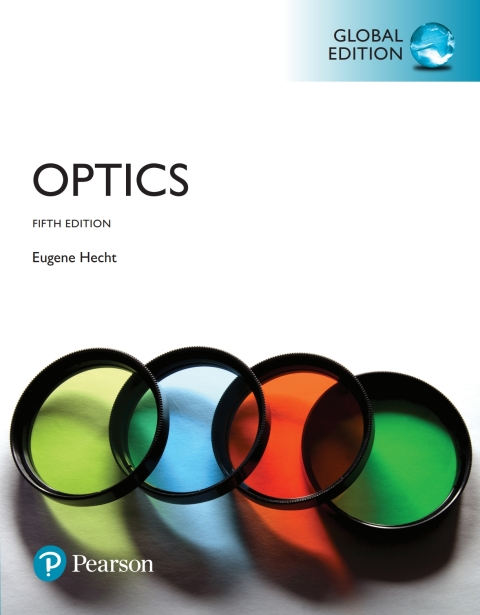Description
Efnisyfirlit
- Title Page
- Copyright Page
- Preface
- Contents
- 1. A Brief History
- 1.1. Prolegomenon
- 1.2. In the Beginning
- 1.3. From the Seventeenth Century
- 1.4. The Nineteenth Century
- 1.5. Twentieth-Century Optics
- 2. Wave Motion
- 2.1. One-Dimensional Waves
- 2.2. Harmonic Waves
- 2.3. Phase and Phase Velocity
- 2.4. The Superposition Principle
- 2.5. The Complex Representation
- 2.6. Phasors and the Addition of Waves
- 2.7. Plane Waves
- 2.8. The Three-Dimensional Differential Wave Equation
- 2.9. Spherical Waves
- 2.10. Cylindrical Waves
- 2.11. Twisted Light
- Problems
- 3. Electromagnetic Theory, Photons, and Light
- 3.1. Basic Laws of Electromagnetic Theory
- 3.2. Electromagnetic Waves
- 3.3. Energy and Momentum
- 3.4. Radiation
- 3.5. Light in Bulk Matter
- 3.6. The Electromagnetic-Photon Spectrum
- 3.7. Quantum Field Theory
- Problems
- 4. The Propagation of Light
- 4.1. Introduction
- 4.2. Rayleigh Scattering
- 4.3. Reflection
- 4.4. Refraction
- 4.5. Fermat’s Principle
- 4.6. The Electromagnetic Approach
- 4.7. Total Internal Reflection
- 4.8. Optical Properties of Metals
- 4.9. Familiar Aspects of the Inter action of Light and Matter
- 4.10. The Stokes Treatment of Reflection and Refraction
- 4.11. Photons, Waves, and Probability
- Problems
- 5. Geometrical Optics
- 5.1. Introductory Remarks
- 5.2. Lenses
- 5.3. Stops
- 5.4. Mirrors
- 5.5. Prisms
- 5.6. Fiberoptics
- 5.7. Optical Systems
- 5.8. Wavefront Shaping
- 5.9. Gravitational Lensing
- Problems
- 6. More on Geometrical Optics
- 6.1. Thick Lenses and Lens Systems
- 6.2. Analytical Ray Tracing
- 6.3. Aberrations
- 6.4. GRIN Systems
- 6.5. Concluding Remarks
- Problems
- 7. The Superposition of Waves
- 7.1. The Addition of Waves of the Same Frequency
- 7.2. The Addition of Waves of Different Frequency
- 7.3. Anharmonic Periodic Waves
- 7.4. Nonperiodic Waves
- Problems
- 8. Polarization
- 8.1. The Nature of Polarized Light
- 8.2. Polarizers
- 8.3. Dichroism
- 8.4. Birefringence
- 8.5. Scattering and Polarization
- 8.6. Polarization by Reflection
- 8.7. Retarders
- 8.8. Circular Polarizers
- 8.9. Polarization of Polychromatic Light
- 8.10. Optical Activity
- 8.11. Induced Optical Effects—Optical Modulators
- 8.12. Liquid Crystals
- 8.13. A Mathematical Description of Polarization
- Problems
- 9. Interference
- 9.1. General Considerations
- 9.2. Conditions for Interference
- 9.3. Wavefront-Splitting Interferometers
- 9.4. Amplitude-Splitting Interferometers
- 9.5. Types and Localization of Interference Fringes
- 9.6. Multiple-Beam Interference
- 9.7. Applications of Single and Multilayer Films
- 9.8. Applications of Interferometry
- Problems
- 10. Diffraction
- 10.1. Preliminary Considerations
- 10.2. Fraunhofer Diffraction
- 10.3. Fresnel Diffraction
- 10.4. Kirchhoff’s Scalar Diffraction Theory
- 10.5. Boundary Diffraction Waves
- Problems
- 11. Fourier Optics
- 11.1. Introduction
- 11.2. Fourier Transforms
- 11.3. Optical Applications
- Problems
- 12. Basics of Coherence Theory
- 12.1. Introduction
- 12.2. Fringes and Coherence
- 12.3. Visibility
- 12.4. The Mutual Coherence Function and the Degree of Coherence
- 12.5. Coherence and Stellar Interferometry
- Problems
- 13. Modern Optics: Lasers and Other Topics
- 13.1. Lasers and Laserlight
- 13.2. Imagery—The Spatial Distribution of Optical Information
- 13.3. Holography
- 13.4. Nonlinear Optics
- Problems
- Appendix 1: Electromagnetic Theory
- Appendix 2: The Kirchhoff Diffraction Theory
- Table 1
- Solutions to Selected Problems
- Bibliography
- Index
- List of Tables
- Back Cover







Reviews
There are no reviews yet.